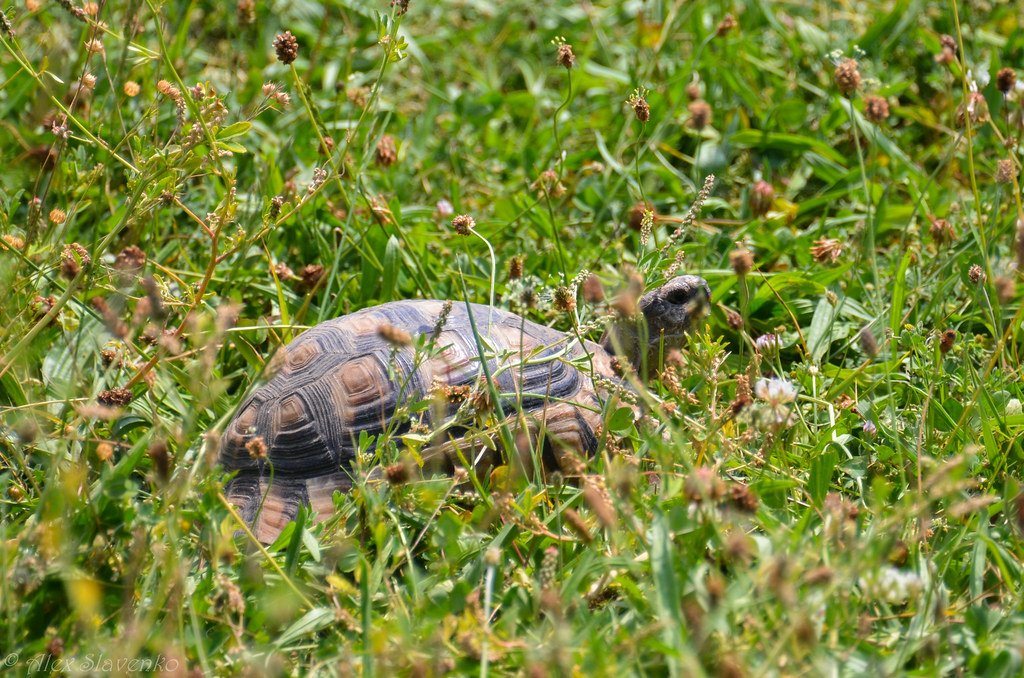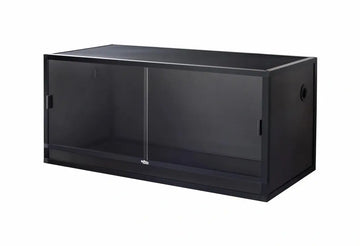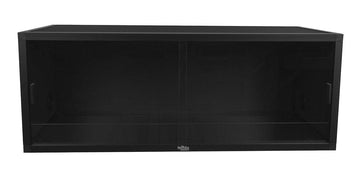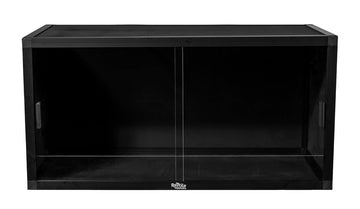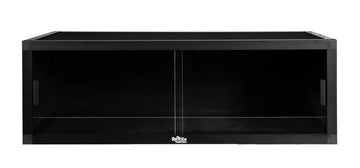The marginated tortoise (Testudo marginata) is a 10-14” long tortoise native to the northern half of the Mediterranean. Their preferred habitat is rocky hillsides and evergreen scrub, and they can be found at elevations as high as 5,000 feet above sea level.
Marginated tortoises are named for the serrated, skirt-like scales that flare outward from the rear portion of their shell. The shell is usually brown-black with cream to yellow highlights on each scute, although it tends to darken with age. The plastron is pale yellow with dark, triangular markings.
Marginated tortoises are fairly hardy as pets, but they have long lifespans, so it’s important to know what you’re getting into before bringing one home. With good care, they are capable of beyond 100 years!
Minimum enclosure size for marginated tortoises
Marginated tortoises larger than 4” long should be housed outdoors for at least most of the year. This is the most practical method of adequately housing a tortoise of their size, as they need at least 100 square feet of floor space to roam. An outdoor marginated tortoise pen must have walls at least 18” tall that extend at least 6” into the ground (24” total minimum). The corners should be capped to prevent escape. There should also be measures in place to deter potential predators and thieves.
Marginated tortoises smaller than 4” are best housed indoors, as they are very susceptible to dehydration at this age. Housing them in an appropriately set-up bin or terrarium makes it easier to provide for their unique needs. This enclosure should be at least 3’ x 2’.
Cohabitation (housing multiple animals in one enclosure) can work with marginated tortoises if they’re more or less raised together, but they can be housed singly as well.
Keep in mind that if your local climate gets colder than ~55°F at night for extended periods during the year, then you will need to have an appropriately-sized indoor enclosure prepared to temporarily house your tortoise until the weather improves.
Do marginated tortoises need UVB?
Yes, a moderate level of UVB lighting is required for marginated tortoises to maintain good health. The best UVB bulbs for marginated tortoises are:
- Arcadia T5 HO 12%
- Zoo Med T5 HO Reptisun 10.0
When the bulb is mounted in an Arcadia ProT5 or Vivarium Electronics fixture, it should be mounted 17-18” above the tortoise’s shell so the tortoise gets exposed to the right strength of UVB.
Your UVB bulb and fixture should be roughly half the length of the tortoise’s enclosure, and left on for 14 hours/day during summer, and 10 hours/day during winter. However, if your tortoise is housed outdoors and has access to sunlight, you will not need a UVB lamp.
Since marginated tortoises need such large enclosures, indoor enclosures require more illumination than just a UVB bulb can provide. Use 6500K LEDs or T5 HO fluorescent grow lights for this purpose.
Best temperature for marginated tortoises
Like other reptiles, marginated tortoises are cold-blooded, which means that they rely on external temperatures to manage their own body temperature and metabolism. A reptile’s enclosure should offer a range of temperatures to allow them to thermoregulate effectively.
Specifically speaking, marginated tortoises should have a basking temperature around 95°F. Ambient temperatures should be between 75-80°F. Nighttime temperatures should be below 72°F. These temperatures should be measured with a digital probe thermometer.
Provide heat for your tortoise with at least two halogen flood heat bulbs, placed close together over the basking area to evenly heat the tortoise’s entire body. Heat lamps should be at least 8” away from the top of your tortoise’s shell.
If you are housing your marginated tortoise outdoors, supplementary heating is unnecessary unless night temperatures fall below 55°F. Nighttime heat sources should not produce light, and should only warm the area up to 55-60°F.
Best humidity levels for marginated tortoises
Adult marginated tortoises don’t need much in the way of humidity except for a designated humid area on the cool side. A hide box lined with moistened sphagnum moss works well for this purpose.
Hatchlings (up to 4” long) are more sensitive to dehydration, and should be maintained in a terrarium with ambient humidity levels around 60% on average. One of the best ways to increase humidity is to mix water directly into the substrate, but the substrate should only become damp, never saturated or muddy.
Humidity should be monitored via digital probe hygrometer, with the probe placed in the middle of the enclosure.
Best substrate for marginated tortoises
Providing a thick layer of naturalistic substrate (“bedding”) will help maintain correct humidity levels and also provide something for your tortoise to dig in as desired. We recommend the a 50/50 mix of play sand and topsoil as substrate for marginated tortoises:
Substrate should be at least 4” deep and completely replaced every 3-4 months. Remove poop and urates daily, along with contaminated substrate.
Marginated tortoises should be housed outdoors on well-draining dirt, not grass lawn. In areas with heavier soils, replacing the soil in that portion of your yard with a sand-soil mix may be necessary.
How to decorate a marginated tortoise enclosure
An empty enclosure makes for a bored tortoise, reducing its quality of life. Keep your pet entertained and engaged with its environment with the strategic use of decor items that encourage it to exercise natural behaviors!
Here are some ideas to get you started:
- additional hiding places/burrows
- large hollow logs
- live, edible plants
- large, flat stones
The more stuff you add, the more functional your enclosure is likely to become! As an additional feature, you can shape the substrate into hills to create more environmental variety for your pet.
What to feed to a marginated tortoise
Marginated tortoises are herbivores, which means that they need a high-fiber, plant-based diet to stay healthy. Offer a variety of chopped greens daily. Variety is key to good nutrition, but most of your marginated tortoise’s diet should be an assortment of leaves and grasses, with occasional flowers. Vegetables can be offered as treats no more than 1x/week.
Safe greens for marginated tortoises: cactus pads, kale, turnip greens, mustard greens, dandelion greens + flowers, hibiscus leaves + flowers, nasturtium, alfalfa, clover, coreopsis, geranium, grape leaves, green cabbage, kale, radicchio, chicory, watercress, fennel, sprouts, endive, radish greens
Vegetable treats: squash, cucumber, mushrooms, peas, beans, thinly sliced carrot
Supplements
You will also need calcium and vitamin supplements to prevent your tortoise from developing a potential deficiency. A little bit of Mazuri tortoise diet or Zoo Med Natural Grassland Tortoise Food makes a nutritious addition.
For additional calcium, place a cuttlebone in the enclosure. Your tortoise will nibble on it as needed, getting dietary calcium as well as filing down its beak!
Water
Of course, don’t forget a water bowl! Marginated tortoises like to soak, so you will need a shallow “puddle” of water for them to soak and defecate in. Use a flower pot saucer or a reptile water bowl with a ramp. Keep the water clean and scrub the dishes weekly with a reptile-safe disinfectant, or whenever it becomes soiled.
Juveniles under 4” long should be soaked daily in lukewarm water for 15-20 minutes per session. This practice helps prevent dehydration!
How to handle your marginated tortoise
Reptiles generally don’t appreciate petting and handling in the same way that dogs and cats do. That being said, marginated tortoises generally tolerate human interaction pretty well! They tend to appreciate gentle scratches and hand-feeding rather than being held.
If you have to pick up your tortoise, be gentle and try to pick it up from the side or below rather than from above. Keep handling time to a minimum.
*This care sheet contains only very basic information. Although it’s a good introduction, please further your research with high-quality sources. The more you know, the better you will be able to care for your pet!
"Testudo marginata" by alexslavenko is licensed under CC BY-NC-SA 2.0

